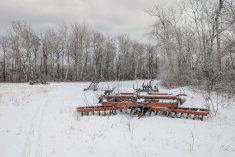Weather patterns point to greater risk of poisoning in livestock this summer due to soil-borne anthrax, the Canadian Food Inspection Agency warns.
Spores that cause anthrax poisoning are known to exist in the soil across Canada’s Prairies and generally surface during the summer, particularly when hot, dry temperatures follow a period of heavy rainfall and/or flooding.
“Given the recent and predicted climatic conditions, the risk of anthrax is poised to elevate this summer,” federal chief veterinary office Brian Evans said in a CFIA release Tuesday.
Read Also

U.S. livestock: Cattle futures surge as second screwworm case announced
Chicago | Reuters – Chicago Mercantile Exchange cattle futures rallied on Friday as two new screwworm cases were announced in…
“(W)e encourage all livestock producers in the Prairies to speak to their veterinarian about having their animals vaccinated, especially if their herd is in an area where anthrax has been found before.”
Five separate herds of animals on the Prairies were confirmed to have suffered from anthrax during 2010, including three in August alone: a bison herd in the southeastern Saskatchewan RM of Wellington, a group of cattle and horses in the neighbouring RM of Fillmore and a cattle herd in the northern RM of Garden River. Cattle from a separate herd in the RM of Fillmore were confirmed with anthrax in early September.
Another case was confirmed in Manitoba in early November, in a cattle herd in the RM of Armstrong, in the province’s rain-soaked Interlake region.
The Prairies also saw five separate confirmations of anthrax in herds the previous year, including two separate cases in western Saskatchewan, a group of three cattle herds plus a bison herd in southeastern Manitoba and a bison herd in northwestern Alberta’s Peace region.
Cases of anthrax have occurred in Canada from Alberta to western Ontario, with “repeated” outbreaks in the Northwest Territories’ Mackenzie Bison Range and in northern Alberta’s Wood Buffalo National Park.
Other precautions
Producers are advised to avoid giving hay that was cut close to the soil, or feed that had contact with soil, to any non-vaccinated animals.
Also, CFIA said, producers should thoroughly clean and disinfect equipment and footwear that may have had contact with contaminated soil, and wash clothes worn when tending to sick animals separately from the rest of the household laundry.
People are susceptible to anthrax infection, CFIA said, but it’s rare to find a human case of anthrax linked to an animal outbreak if proper precautions are taken during the handling and movement of affected animals and carcasses.
In highly susceptible species such as cattle, the time between onset of mild symptoms and death can be a matter of hours, CFIA said. Often the first sign of an anthrax outbreak is one or more sudden deaths in affected livestock.














